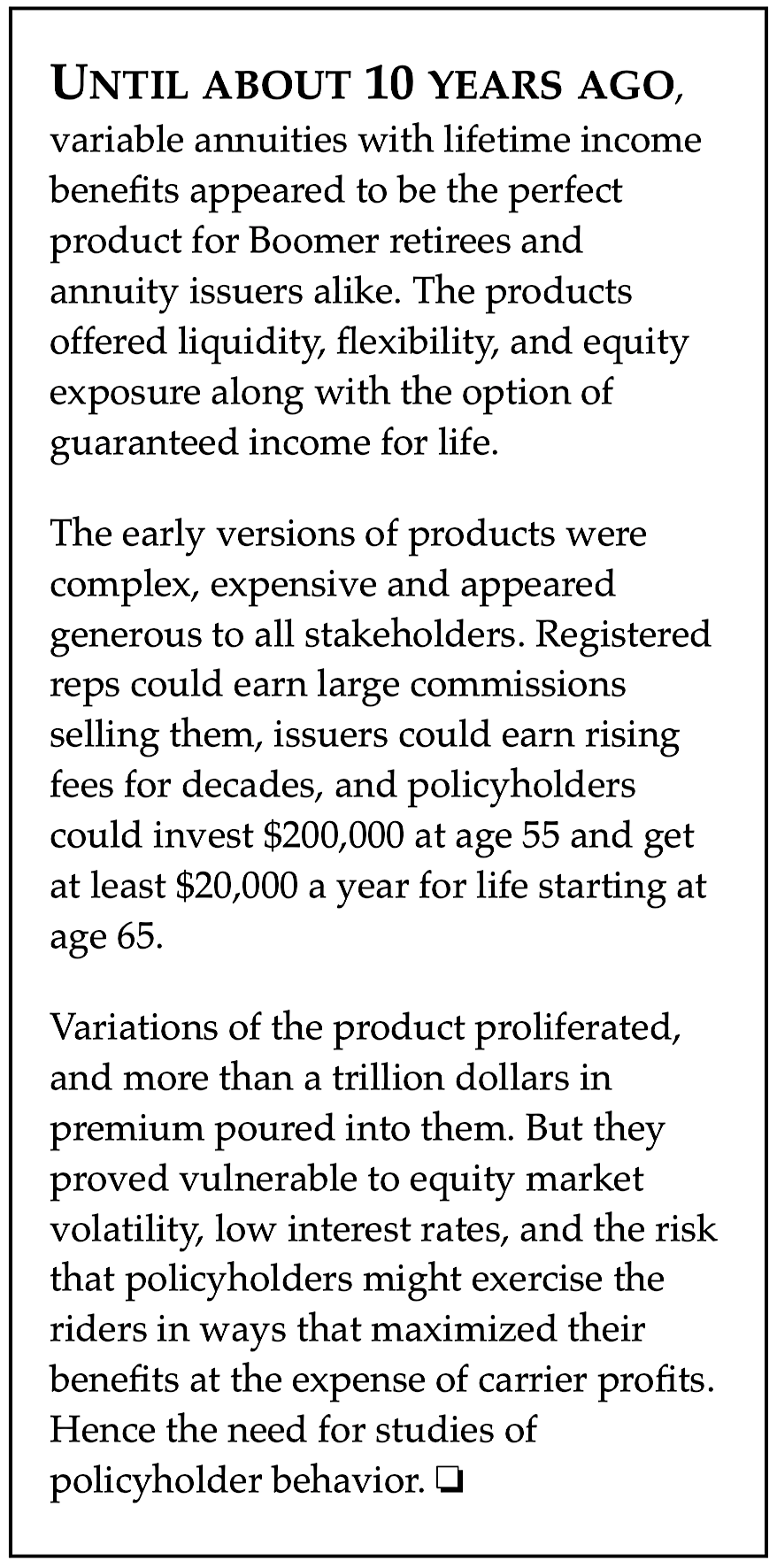
Older Americans own some $2.2 trillion worth of in-force variable annuity contracts, including about $894 billion in contracts with riders allowing the policyholders to convert their balances into income streams that are guaranteed to last as long as they live.
Actuaries at the issuers of those contracts have to predict (or “model”) the future behavior of the policyholders. They ask questions like: Which owners will switch on income, and when? How many will let their riders lapse? What is the “moneyness” of the contracts? That is, what are the assets worth relative to the liabilities? (More on that below.)

Timothy Paris, CEO of Ruark
The answers to those questions help quantify the risks to the issuer, and help determine the amount of money that issuers need to set aside to support the guarantees. To obtain those answers, many of the large issuers contribute data on policyholder behavior to ongoing studies by Ruark Consulting, LLC, an actuarial consulting firm in Simsbury, Conn.
Ruark’s latest survey
Ruark recently released the results of its 2020 industry study of variable annuity (VA) policyholder behavior. The survey covered 89 million policyholder-years for 13.9 million VA policyholders from 20 participating companies with $675 billion in account value as of the end of the study period, from January 2008 through June 2020. It included data on surrenders, income utilization and partial withdrawals, and annuitizations of VA contracts.
In addition to the usual death benefits and other riders, these contracts had either GLWB riders (guaranteed lifetime withdrawal benefits), which pay an age-related percentage of an account value with a floor) or GMIB riders (guaranteed minimum income benefits), which pay the policyholder a minimum monthly or annual amount.
Overall, the study contained good news for VA issuers; most policyholders use the rider as the carriers intended them to. Under the terms of the riders, a policyholder receives benefits only if he or she a) initiates a stream of payments from their account (at a rate capped by the carrier), and b) are still living when their own money runs out (i.e., when the value of their underlying mutual funds hits zero).
Ruark found that only about 13% of policyholders turned on their income streams in the first year of ownership. In each of the second through 10th years, they turned on income at about half that rate. But “commencement rates more than double in year 11 with the expiration of common 10-year bonuses for deferring income.” After they start taking guaranteed income, more than 85% take it as long as they can.
Policyholders and their advisers, Ruark has shown, are quite aware that, after a market crash or a drop in interest rates, the rider guarantee becomes more valuable or “in-the-money.” After such an event, their account value might be lower than the present value of the guaranteed income stream. Knowing that this is the adverse event that the rider insures them against, they tend to turn on the minimum income stream right away in hopes of seeing money from the insurer before they die.
COVID-related findings
The study period for 2020 was designed to capture early effects of COVID-19 and related market movements. Ruark’s COVID-related findings include:
- The in-the-money exposures on GLWB contracts were 23% higher than in Ruark’s 2019 study (and 40% higher for contracts deepest in-the-money).
- Among contracts issued since 2011, deep in-the-money exposure increased to 9% of total exposure, up from 6% in 2019. The study contained over 740,000 exposure years prior to withdrawal commencement for contract durations 11 and beyond, more than doubling the comparable exposure in Ruark’s 2019 study.
- Contracts with guaranteed lifetime withdrawal benefits (GLWB) persisted at greater rates than expected, as current-generation products exhibited greater sensitivity to 2020 market movements than they did in the past.
- Surrender rates fell uniformly on older product types in 2020; this is suggestive of a new, unique surrender practices, distinct from the practices observed before and after the 2008 financial crisis.
- GLWB commencement rates were depressed in 2020 among contracts with the highest propensity to exercise the benefit: in-the-money contracts following the end of the deferral bonus period.
“We expected that 2020 behavior would be different,” said Timothy Paris, Ruark’s CEO. “By looking at industry-level data, we are better able to identify and quantify those differences— especially on the most recent products.”
‘Moneyness’
For annuity issuers with many billons of dollars in long-term VA rider liabilities, the big question is this: Given trends in interest rates, performance rates of funds in the separate accounts, contract lapse rates, and owner survivor rates, what level of claims can I expect in five, 10 or 20 years? How much reserves and capital do I need to hold to support those anticipated claims?
Actuaries don’t have digital crystal balls, but they do have metrics to tell them whether contracts are currently “out of the money” (not on course to trigger a claim before the client dies) or “in the money” (on course to trigger a claim). They also have two yardsticks—nominal and actuarial—to measure the “in-the-moneyness.”
An income rider is nominally in-the-money if and when the owner’s account value is below the guaranteed “benefit base.” This is the notional minimum amount on which the clients’ income payments will be calculated. Initially equal to the account value, the benefit base may later be higher or lower than the account value. For instance, a client’s investments may start at $100,000 and then fall to $95,000, but the benefit base can’t be less than $100,000. After 10 years of annual deferral bonuses, the benefit base might be $200,000, regardless of the actual account value.
Contracts are actuarially in-the-money—and pose the greatest risk of loss for the insurers—if the owners are also on track to live past the point when they will have begun receiving benefits from the insurer’s general fund instead of their own separate accounts. The fewer the number of clients who reach the point of receiving money from the general fund, the more profitable the product to the issuer.
Some owners of VA living benefits (either guaranteed lifetime withdrawal benefits or guaranteed minimum income benefits, which are more like deferred income annuities with a floor) never use the rider. At a certain age, they may no longer believe they need the protection, so they’ll surrender the contract and stop paying the fee for the GLWB or GMIB rider. Other owners (and their advisers) are very savvy. They know when the contract is nominally or actuarially in the money, and they will act accordingly.
Which assumption should issuers of VAs with income riders model their future liabilities (and reserve requirements) base their future liability and reserve estimates on—nominal or actuarial moneyness?
“Some issuers argue that annuity owners are not actuaries or calculating machines,” Paris told RIJ. So they’ll look to simpler proxies, like ‘nominal moneyness.’ Others believe that while annuity owners aren’t doing detailed calculations, they have some sense of actuarial/economic value. So they use an actuarial moneyness measure. We spend more time talking with our clients about this issue than anything else, because it is critically important to the long-term profitability of these products.”
© 2021 RIJ Publishing LLC. All rights reserved.

